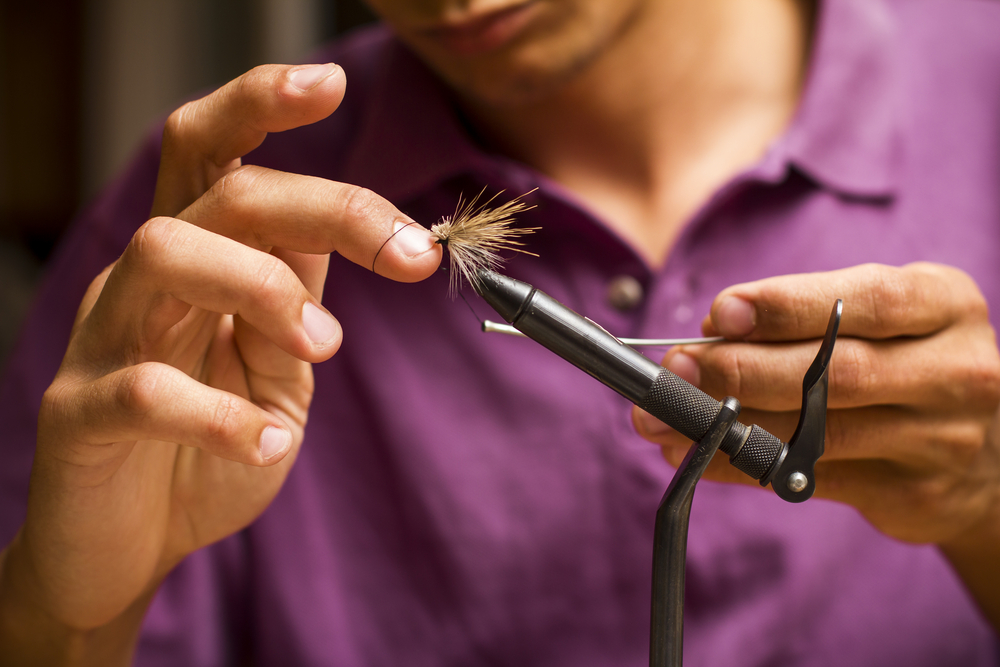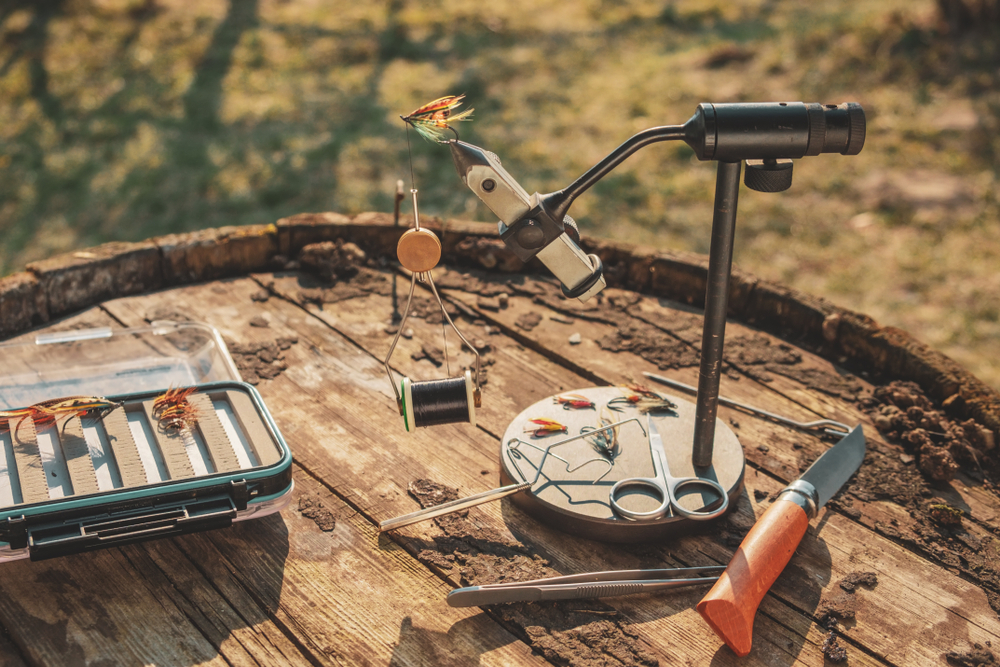What Is Fly Tying?
As the name suggests, fly tying is the act of binding together materials around a hook with some thread, serving as a lure for the popular recreation of fly fishing. The sport has been around for centuries, but the art of fly tying truly began in the 19th century during a time when both technology and fishing in general began to be advanced at rates never before seen in the world. The sport moved from a needed food yielding pursuit to a more leisurely activity, though there still existed the payoff of bringing home a meal to the family. Remarkably, many of the same techniques and even tools haven’t changed that much since the late 1800’s.
To understand how fly tying works, it is important to grasp what the aim of the craft is: emulating the prey that certain species of fish go after. Commonly, flies are supposed to mimic, well, actual flies and other insects, but this isn’t always the case. Depending on the fish you are after, your artificial fly could look like a nymph, larvae, worm, or even little reptiles. If you’re saltwater fly tying, you’ll need your flies to imitate baitfish and even crustaceans in addition to the traditional insect-like bait.
It is also very crucial to understand that the fly needs to act the way it would in nature. This is primarily up to whether you are dry fly fishing or wet fly fishing. The former is the more popular of the two styles, where your bait is meant to be floating on the surface like an injured insect or other source of food. Meanwhile wet fly fishing has the lure sink well beneath the surface, imitating a small fish or hatched insect. Mixed in between the two is something called an emerger, a fly that stays submerged just beneath the surface like a shallow floater. The way you tie your fly depends on how you choose to fish.
Tying your own flies takes a lot of tools and materials, but it can be done right in your very own home, saving you money in the long run as you spend less on flies at your local bait shop. In addition, tying your own flies give you the advantage of custom-made lures designed to your preferences, and catching a fish can feel more rewarding with your own product. If you get really good, you can earn a little extra income selling flies you make, or you can even try your hand at one of many fly tying competitions around the world. But until you get to that point, you’ll need to learn the fly tying basics.
What Types Of Fishing Use Fly Tying?

The iconic image of the fly fisherman shows him in the traditional sun hat with a vest, casting his line in a zen state in an alpine river or similar mountain stream. Those who practice trout fly tying or salmon fly tying may indeed end up enacting this exact scenario, but not all fly tiers are looking to fish in a river environment. There is, in fact, a huge range of different fly fishing experiences out there to be had.
In fact, there are many fly tying techniques that can help the beginner understand how to fish in a variety of aquatic ecosystems in order to get the best results. If you’d rather stick with the open seas, then you should give saltwater fly tying a try. The challenge of reeling in a monster ocean fish can be more exhilarating with a lure you created, fishing a style that is generally more challenging than others. Saltwater fly fishing is normally performed from a boat, but can also be done from the shore or even while standing in the surf – there are many ways to leverage the power of a well-tied fly to get incredible results for your angling experience. Common saltwater species for this style of fishing includes bonefish, redfish, stripers, tarpon, halibut, and for the adventurous out there, mako sharks.
Freshwater fly fishing is where the sport truly gets its popularity, however. Rainbow trout, steelhead, and other forms of trout and salmon are the primary quarry, but other fish in recent times has been getting some attention, like largemouth bass. Popular bass fly tying patterns include nymph, minnow, leech, and crayfish, with any kind of light surface popper to really entice this game fish. Northern pike is another fish that has become more prevalent in fly fishing, though the lures you tie for this species will have to be much longer and tougher than average.
What Do You Need To Start Fly Tying?
There are a wide range of tools and materials used in the hobby or trade of fly tying creation. No matter if one is at the beginning hobby level or an advanced pro, having the right fly tying material is an absolute must. There are plenty of different types of material that can be used and it will depend on the recipe being used, but we’ll cover some basics to give you a better understanding of how this art works.
Basic materials you will need:
- Vise
- Scissors
- Assorted hooks
- Bobbin (a tool that allows spools of thread to come out more efficiently)
- Various colors of thread
- Assorted dubbing (material used to give the fly its body)
- Assorted feathers and hair
- Various sizes and colors of beads
- Fly tying cement or glue
These are just the basic needs for any fly fisherman. You can get these materials at most bait shops, otherwise you’ll have to get creative with local hardware and department stores, or shop online, of course.
The vise has become a mandatory tool in the fly tying industry. Instead of trying to tie the whole thing with your hands, attaching a fly to a vise will free both hands, allowing for more elaborate designs and a more careful approach.
To create a realistic fly, the craftsman will need access to fly tying thread that is specially chosen to carefully replicate the look and feel of a fish’s source of food. Sometimes fly tying feathers are applied, not for decorative reasons, but in order to give the feel of a flying bug that fish will readily strike at once it touches the surface. Finding the right pattern takes time, but you can get some guidance searching online or through an expert to learn some perfect fly fishing recipes. There are hundreds of recipes out there, known by such colorful names as green paradrake, elk hair caddis, and Parachute Adams. Getting a hold of the recipes for these kinds of flies will help you get started on the right path.
Other important terms you will come across include fly tying hackle and dubbing. Hackle refers to the feathers you attach to your fly, while fly tying dubbing is the material you use to represent the body of whatever bait you are trying to reproduce.
How Do You Learn Fly Tying?

Learning the art of tying the perfect fly can be a tricky thing. This is not a very intuitive activity, as it requires high quality instructions from a source that is not only knowledgeable, but skilled enough to relay information in an understandable way.
There are fly tying books which offer a number of different and sometime highly specialized sets of fly tying instructions, but these are primarily used by those who want a reminder while out in the field. Fly tying videos may be your best bet because it is much easier to understand how recipes are followed when you can watch it in motion.
If you’re the kind of person that learns better with a teacher then perhaps the best option of all is to join a fly fishing club. Not only will you learn the proper fly tying techniques from experts and fellow passionate anglers, you will have access to recipes and tools, getting practical experience tying flies in the process.






